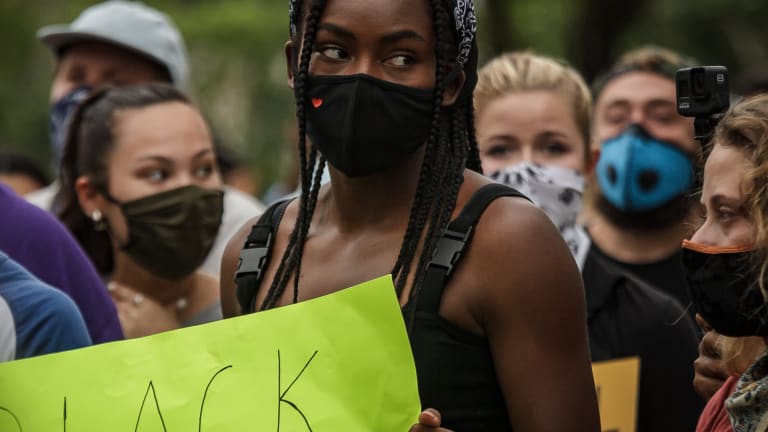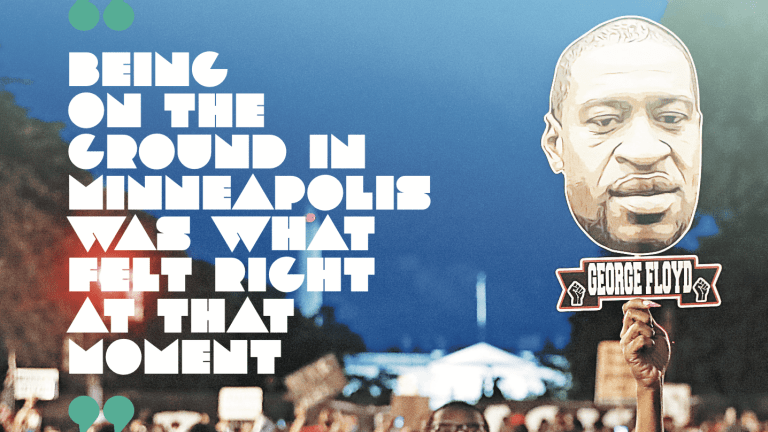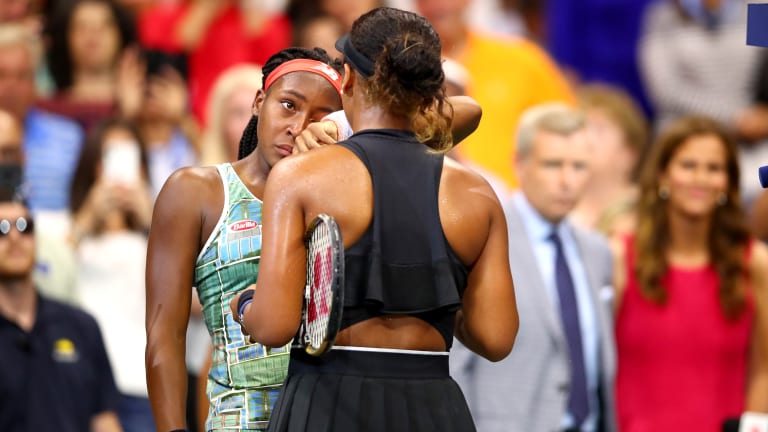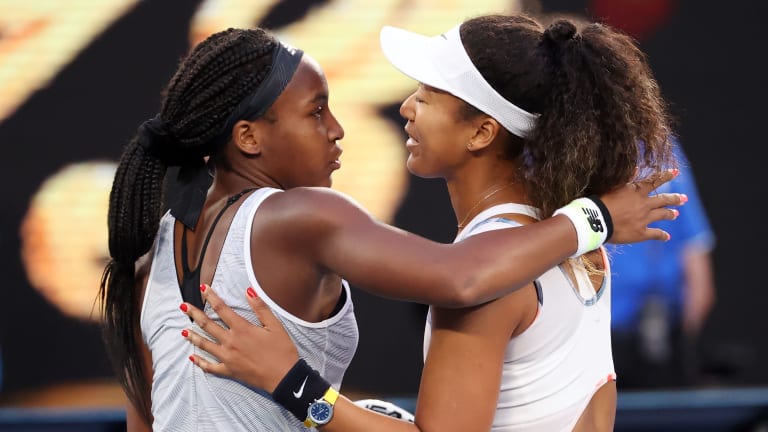Direct Message: How Coco Gauff & Naomi Osaka are leading a generation
By Matt Fitzgerald Aug 10, 2020Naomi Osaka is leaving the sports agency she co-founded
By TENNIS.com Dec 19, 2025Coco Gauff is Forbes' highest-earning female athlete for second year running
By TENNIS.com Dec 18, 2025Naomi Osaka revives Nike “Lolita goth” look at Garden Cup match vs. Aryna Sabalenka
By David Kane Dec 09, 2025The Garden Cup brings tennis’ biggest personalities back to NYC
By Stephanie Livaudais Dec 08, 2025Coco Gauff tops Sportico's highest-paid female athletes list for third year running; Sabalenka, Keys make major jumps
By TENNIS.com Dec 04, 2025What’s on Tennis Channel before the 2026 season kicks off?
By TENNIS.com Nov 24, 2025Naomi Osaka set to cameo in Meghan Markle's 'With Love, Meghan' Netflix holiday special
By TENNIS.com Nov 21, 2025Swiatek, Gauff, Osaka, Auger-Aliassime, Zverev among 2026 United Cup entrants
By TENNIS.com Nov 17, 2025WATCH: Naomi Osaka, Taylor Townsend maximize joint slay in off-season TikTok
By David Kane Nov 12, 2025Direct Message: How Coco Gauff & Naomi Osaka are leading a generation
Last year, the two became the story of the US Open for their post-match moment. In the 12 months that followed, both have become leaders of a generation with their unambiguous responses to another moment, one that extends far beyond the sport's arenas.
Published Aug 10, 2020
Advertising
This story was featured in the September/October 2020 issue of TENNIS Magazine.
On June 4, Coco Gauff stood front and center like she had done so many times over the past 12 months.
Though on this occasion, her platform was not a show court, and instead of frenzied tennis fans watching her intently, this audience was a group of social activists gathered outside Delray Beach City Hall. The pressure was still as high as ever for the Florida-born 16-year-old, who stepped up to a podium after her grandmother, Yvonne Lee Odom, a well-known treasure within the community, had captivated the crowd with the wisdom cultivated through her own groundbreaking experiences.
Nearly 60 years earlier, Odom was the first student to integrate Delray Beach’s Seacrest High School (now Atlantic Community). Most 15-year-olds would have been uneasy or terrified about the weight of the situation. But Odom wasn’t a typical 15-year-old—she strolled through the hallways and met probing eyes with precocious poise, implanted integrity and an unbreakable backbone.
“When you’re in that spotlight, you don’t realize you’re in a spotlight,” she says.

Direct Message: How Coco Gauff & Naomi Osaka are leading a generation
Advertising
From the very beginning, Gauff, like her grandmother, has been “spectacularly” different. A devoted teacher and matriarch, Odom was set to host daughter Candi for her baby shower on a Sunday. While coincidentally attending another friend’s shower the day prior, Odom received a call that Candi’s water had broken. Sure enough, Coco entered the world on her own terms that Saturday.
“What I did was, I got a picture of her and the baby, because it was too late to cancel the shower,” she says with a laugh. “We went on with it, so the mom nor the baby were at their own shower.”
As Gauff grew, Odom kept note of her unique tendencies. When Candi and husband Corey were living in Atlanta, Odom vividly remembers picking up Gauff from nursery school one day. The children were all asked to write down their favorite food, with french fries and McDonald’s dominating the selections. Gauff’s pick, however, was broccoli. Odom was puzzled, but Gauff stated her case by proclaiming, “my children need vegetables too!” Church Sundays also opened Odom’s eyes to Gauff’s thoughtfulness.
“Out of all the grandchildren, she would pay attention to what the preacher was saying,” she says. “We are long-winded, our service usually lasts a couple of hours, so she paid attention and even pretended she was taking notes.”
Listening and independent thinking are virtues that have stayed with Gauff as she develops into one of the most promising prospects—and leaders—in tennis. It’s visible on the practice court, it’s evident in the press room and it’s clear on social media. In late May, when fellow African-American George Floyd was helplessly killed by a white police officer kneeling on his neck while in custody, Gauff tweeted, “I promise to always use my platform to help make the world a better place.” In talking with Odom, it’s undeniable that value has been passed down in her family from generation to generation.
Grandmother and granddaughter have maintained a close bond, with Odom growing accustomed to Gauff’s resolve.
“We’ll play a game of Connect Four and I’ll win the first game,” says Odom. “First thing she’ll say is, ‘best two out of three.’ Next thing I know I’ve lost like nine games in a row.”
When Odom and Gauff each took the microphone in Delray Beach, neither was aware of the other one’s plans. Odom, a Stage 4 lung cancer survivor, initially had concerns about COVID-19, but made the decision to participate. She knew Floyd’s death had affected her granddaughter personally, because Gauff did something completely out of character.

Direct Message: How Coco Gauff & Naomi Osaka are leading a generation
© ZUMAPRESS.com
Advertising
“Her mom shared with me that Coco canceled her practice, and one thing I know about Coco is she never cancels practice,” says Odom. “So, she’s always had this self-determination that she’s going to do what she wants to do. You can ask her mom or dad if they want to try to help with her speech, but she knows what she wants to say. She has her own mind and I applaud that.
“I always tell my kids, as long as you’re honest and you’re not lying, you have to speak your own heart. I think Coco is well on her way.”
As Gauff settled in at the podium, the command and poise beyond her years the world had come to admire—and now expect—took over. For 140 seconds, no racquet was required for Gauff to engage those watching. Impassioned to speak out about injustice for Black Americans, the tennis wonderkid channeled inspiration from Martin Luther King Jr. by contending those choosing silence are on the same side of the net as purposeful oppressors. At 16, Gauff cannot yet exercise her voice further at the polling station, yet that didn’t prevent her from championing those with the privilege to honor it.
“I think it’s sad I’m here protesting the same thing that [my grandma] did 50-plus years ago,” said Gauff. “It’s in your hands to vote for my future, for my brothers’ future, and for your future. That’s one way to make change.”
Two days later, Gauff shared photos and a video message from the demonstration in an Instagram post. Her caption carried through MLK’s dispatch of speaking up when the stakes are high, eliciting more than 400 replies. One response from a two-time major champion garnered the most attention, when Naomi Osaka wrote back in support, “Nothing but respect for my president.”

Direct Message: How Coco Gauff & Naomi Osaka are leading a generation
Advertising
Before the two stepped under the lights on Arthur Ashe Stadium for their third-round match, Osaka was reminded of the pair’s formative years when seeing Gauff’s pre-match ritual, a hug from Corey.
“I literally was training at the same place as her. We would never hit together, but it was always just us putting in the most amount of hours. She was always with her dad just practicing,” Osaka reflected in a press conference at Flushing Meadows. “Honestly, I think she was practicing more than me. Then I was with my dad. Just when I saw them hug, I was, like, Oh, my God… where’s my dad at? My dad doesn’t care about me (laughter). Then I started getting a little bit emotional. I need to put my game face on.”
The defending champion overwhelmed the blossoming teen in 65 minutes, winning the final eight games of their highly-anticipated meeting. Crushed, Gauff rushed to pack her bag as she fought back tears. Osaka soon approached—and encouraged—the adolescent to let it out on court, rather than cry alone in the locker room shower, by joining her for an on-court interview.
“I just want to say, you guys raised an amazing player,” Osaka said to Gauff’s parents, as she too, struggled to contain emotions that had built up. “For me, the fact that both of us made it, and we’re both still working as hard as we can, I think it’s incredible.”
Gauff would tell reporters afterward in the main interview room, “I think a lot of people see the more pumping-up side of me, the more fiery side. I guess that side is good for other people to see. I’m glad I was able to experience that on the biggest stage.”

Direct Message: How Coco Gauff & Naomi Osaka are leading a generation
© Getty Images
Advertising
As the Floyd protests mounted around the U.S., observers began witnessing a different side of Osaka. The youngest daughter of a Japanese mother and Haitian father, Osaka’s endearing introversion, refreshing modesty and frequent self-deprecation are a handful of the qualities that have empowered the 22-year-old to stand out in a crowded carousel of stars.
The highest-paid female athlete over a 12-month period in history, according to Forbes’ annual list published in May, Osaka initially shared personal experiences from the frontlines, having traveled to Minneapolis to join protests in the days after Floyd was killed. In an essay for Esquire, Osaka shared the impetus behind that decision. With the WTA tour suspended, the COVID-19 pandemic forced the former world No. 1 to reexamine priorities, and more importantly, determine where and how she could generate the utmost impact.
“It’s a reset that perhaps I greatly needed. I asked myself, ‘If I couldn’t play tennis, what could I be doing to make a difference?’ I decided it was time to speak up,” Osaka penned. “I flew to Minneapolis with my boyfriend days after the murder to pay our respects and have our voices heard on the streets. We grieved with the people of St. Paul and protested peacefully. We visited the George Floyd memorial and connected with those who came together to mourn yet another senseless act and life lost without reason. Being on the ground in Minneapolis was what felt right at that moment.”
This. pic.twitter.com/lauBz7Lppa
— NaomiOsaka大坂なおみ (@naomiosaka) June 3, 2020
Advertising
Osaka returned to march in Los Angeles and signed petitions about racial injustice. Her Twitter feed soon replaced jokes and embarrassing anecdotes with clear calls for action. She began taking on critics by redirecting her sense of humor to ridicule tweets and Instagram comments with racist undertones, writing back at one point, “You people? Who is you people?” Accounts telling her to stick to sports were roasted. “I hope that fish eats you,” she clapped back to one user, whose profile picture showed an older white man posing next to his catch of the day.
“I’m vocal because I believe in the movement and want to try to use my platform to facilitate change,” Osaka explained to Reuters. “Using humor is definitely one mechanism to expose these people. Calling them out for their ignorance and racism is also worthwhile sometimes.”
Mari Osaka has never doubted her sibling’s steadfastness after being on the receiving end of Naomi’s conviction daily. The eldest by 18 months, Mari would come out victorious each time in the pair’s matches, but Naomi was never deterred, instead decreeing, “I’m going to beat you tomorrow.” While Naomi would eventually turn the tide, her drive set an example for Mari to follow.
“I think that most other people would have given up and not wanted to continue grinding if they kept losing like that, but Naomi never gave up,” Mari says. “Her focus is unmatched. Of course, people see that during her biggest matches, when she maintains her composure through the ups and downs, but it’s also evident when she’s just living her day-to-day life.
“One thing to know is that Naomi is very authentic, so if she feels strongly about something, she will speak up about it. Just like with her work, when Naomi decides to commit to something, she puts herself in 100 percent and is not afraid of criticism if she knows that it’s the right thing to do.”

Direct Message: How Coco Gauff & Naomi Osaka are leading a generation
© AFP via Getty Images
Advertising
The now 73-year-old Odom wasn’t discouraged in her first parent-teacher open house, when a white mother transferred her child upon learning Odom was Black. Odom, viewing that moment as the parent’s loss, would go on to educate future minds in Delray for 45 years. When she was diagnosed with aggressive cancer, Odom didn’t learn about her odds until her family disclosed it was nine percent. She retorted by saying the mortality rate wasn’t 100 percent.
After two years of chemotherapy sessions, Odom was cancer-free. Listening and attitude are rooted in this experience, and all that preceded Odom, as she encourages the generations that follow her to never let any person or event turn one’s persistence into pretext.
“One thing I’ve learned is we have this innate ability to bounce back, no matter what is thrown in your face,” Odom states. “I remember George Wallace saying, ‘segregation now, segregation today, segregation forever.’ Just know that you can persevere, but don’t make excuses. Excuses don’t do anything but help you to fail.”
Mari concluded a “love letter” to Naomi in Glamour with a similar sentiment, urging her younger sister to, “Stay hungry [and] keep going for it. Honestly, there’s nothing that can really stop you. Except for maybe me next time we have a rematch.”
Gauff and Osaka haven’t let up on their social-media accounts, with BLM remaining a focal point. Odom remembers the days of being the only household on her street with a television, and the neighborhood’s party line telephone. At the insistence of her granddaughter, she’s now on Instagram and Facebook, mostly as a lurker, and respects Gauff and Osaka for recognizing the power their platforms can have if used for good.
“You have to allow them to use their skills. It’s a valuable tool if used in the right way,” Odom says. “We used what we had. And each after is going to have to use what they have to make this world a better place, because this world is getting smaller.
“You have to foster these young people and give them wings. You’ve got to be able to trust that they’re the ones who are going to make this world a better place. But they don’t accidentally make it a better place.”
It’s no accident that Osaka and Gauff both make the sports world a better place. If they stick to the principles that have enabled each to stand out on their own, the entire world can, and will, be greater for it.